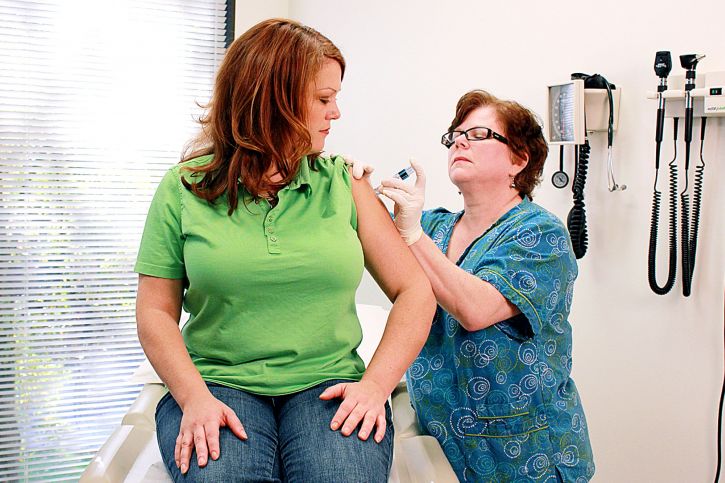In a nutshell:
- As the coronavirus rolls on, it’s easy to forget that flu season is also on the horizon.
- Some fear a “perfect storm” is brewing, but public health measures to slow the spread of COVID-19 are also effective against other respiratory diseases; it’s difficult to predict how the this year’s flu season will play out amid a global pandemic.
- The pandemic response has been hindered by misinformation and politicization, but the looming spectre of vaccine hesitancy is one threat that should not be ignored and that can be addressed through public policy.
Flu Season
The arrival of Autumn heralds a number of different seasons. While election season is clearly in full swing, the ongoing coronavirus pandemic has prevented a normal seasonal start for many other activities, from sports to the performing arts. Flu season, however, might still be right on schedule.
Judging by the numbers, the burden of illness in the U.S. was very high during the 2017-18 flu season – estimated 48.8 million cases, 959,134 influenza-associated hospitalizations, and 79,416 influenza-associated deaths. This was the largest number of cases of influenza-associated illness since the 2009 H1N1 pandemic (when an estimated 60.8 million Americans were sickened). These two recent examples are reminders of how dangerous seasonal influenza can be, and yet the Centers for Disease Control and Prevention (CDC) estimated that only 37.1 percent of adults in the U.S. were vaccinated during the aforementioned 2017-18 season.

The Impending Collision of Flu and COVID-19
SARS-CoV-2, the virus that causes COVID-19, is wholly different from influenza viruses. The diseases brought on by these viruses (while overlapping on some symptoms) are likewise very different. It is difficult to predict what might happen if/when they collide as they spread through the population.
Many are hopeful that ongoing behaviors like mask wearing, hand washing, and physical distancing may work to reduce the severity of this flu season, a possible scenario with supporting evidence from Hong Kong, Japan, Taiwan, and Qatar, to name a few. Indeed, flu season appears to have been much less severe in the Southern Hemisphere amid the ongoing pandemic.
There is no absolute certainty that the same scenario will play out in the Northern Hemisphere; some worry that a perfect storm may be on the horizon. After all, factors that cause the development of pneumonia (i.e., influenza) are a leading cause of death in non-pandemic years.
We still know little about the nature of coinfection with SARS-CoV-2 and other viruses.
In the case of influenza: We don’t yet know how SARS-CoV-2 might affect the risk of influenza infection (and vice-versa). We don’t know if the risk of severe illness would be amplified by coinfection (though we can logically make this assumption). We don’t entirely know what should be done to alter therapeutic regimens just yet. We also don’t know how coinfection could influence viral shedding.
There is little question, however, that a severe flu season combined with ongoing spread of SARS-CoV-2 would overwhelm hospitals and public health departments alike. The capacity to quickly test and distinguish between flu and COVID-19 will be essential moving forward.
We can hope, however, that tried and true public health measures being deployed against SARS-CoV-2 will reduce the spread of other viruses that are not as readily transmissible.
Vaccine Hesitancy, Flu Shots, and SARS-CoV-2
In our 2018 report, An Ounce of Prevention: What Public Health Means for Michigan, we highlighted the fact that a majority of Michiganders skip a seasonal flu shot, even though influenza is a substantial source of morbidity and mortality. This creates risks and costs for every person in Michigan, including increased health care spending and diminished productivity because of missed work or school—to say nothing of avoidable hospitalizations and premature deaths. Policies that remove barriers to vaccination and increase the number of people getting flu shots (and other vaccines) should therefore be encouraged.
Today, more than half of the Michigan population continues to avoid or neglect the seasonal flu vaccine each year. Michigan’s rate of flu vaccine utilization falls below the national average for both children and adults. Some Michigan counties—particularly those with large proportions of low-income and/or rural residents—have especially low rates. There are also longstanding racial disparities in influenza vaccination. It is especially important to address these differences in flu vaccine utilization since severe influenza (requiring hospitalization) is more prevalent in lower-income communities that already suffer from poorer health overall.
A previous blog highlighted that vaccine hesitancy is among the greatest threats to global health. While people typically conceptualize vaccine hesitancy with respect to parents’ perception of recommended childhood vaccines, vaccine hesitancy also affects the way flu shots are perceived and is likely to affect uptake of any forthcoming vaccine for SARS-CoV-2.
From the start of the pandemic, anti-vaxx groups have spread a variety of false narratives about COVID-19. While any forthcoming vaccines to combat the disease are unlikely to be the magic bullet that some hope for, vaccine hesitancy is an expanding minefield on the public health battleground.
Misinformation alleging that flu vaccines increase the risk of developing COVID-19 have also surfaced, holding the potential to negatively impact Michigan’s already-suboptimal flu vaccination rates.

Policy Response
The same dangers of politicization and misinformation that have surrounded the use masks and other face coverings are applicable to all public health interventions and/or recommendations. Mixed signals from public officials combined with decades of growing mistrust in government have hindered the coronavirus response throughout the U.S. Similarly, political posturing around any forthcoming vaccines will benefit no one.
Nonetheless, government has a crucial role to play when it comes to vaccines, promoting research and development, ensuring safety and efficacy, facilitating the logistics of supply and distribution, and addressing barriers that may stand between citizens and valuable public health measures (such as issues of cost and access). It should be clear to all that the government’s role in public health, therefore, is one of policy, not of politics.
Since personal beliefs are a major driver of low flu vaccination rates, public policy cannot afford to ignore the growing threat of vaccine hesitancy.
Addressing individual and community anti-vaccine attitudes holds the greatest potential to increase the state’s vaccination rate. Multifaceted efforts are needed to counter misinformation and assuage concerns or doubts. Given the prevalence of anti-vaccine sentiment, this will not be easy.
While substantial resources are expended on making biomedical advances, these advances are of little value if the public resists them. More attention must be placed at the intersection of public health, marketing, and education to identify effective strategies for engaging the general populace in public health efforts, particularly when it comes to preventative measures and/or health-enhancing behavioral changes. Building vaccine confidence is an increasingly important area of focus.
The state health department has several ongoing strategies to increase influenza vaccination rates, but, as with any effort, the effect of these strategies will be bounded in part by the limited resources dedicated to them. Yet, influenza vaccination rates in Michigan remain far below the Healthy People 2020 target of 70 percent of the adult population. Immunization programs provide health and economic benefits to society, and efforts should be redoubled by making public health a greater budgetary, administrative, and legislative priority.
Some may question any public investment in a flu vaccination push that might inadvertently pare public resources away from the response to COVID-19. While there may already be reason to hope for a mild flu season this year, increasing the number of people getting flu shots will improve these odds further.
It’s also important to consider that the ongoing pandemic has not erased Michigan’s litany of other public health risks and crises; it has added to them. Michigan’s coronavirus response, therefore, must not be allowed to supplant other ongoing public health priorities and services.
At the same time, it is also essential to make advanced planning for an eventual COVID-19 vaccination program an ongoing priority. A proactive COVID-19 vaccine educational campaign will be needed before any vaccine becomes available to ensure that people have access to clear and accurate information about forthcoming vaccines and the associated benefits/risks. Particularly with efforts to produce a vaccine at “warp speed,” clear and transparent communication about the development and approval process is essential; conversely, every effort should be made to keep discussion of vaccines out of political debates.
Amid the growing threat of health misinformation, public investment in the capacity of Michigan’s underfunded state and local public health workforce to scale up communication and messaging strategies that are rooted in science is sorely needed and could pay dividends long into the future.


